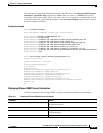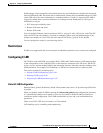
10-42
Cisco ASR 901 Series Aggregation Services Router Software Configuration Guide
OL-23826-09
Chapter 10 Configuring Ethernet OAM
The router does not generate Link Fault or Critical Event OAM PDUs. However, if these PDUs are
received from a link partner, they are processed. The router supports sending and receiving Dying Gasp
OAM PDUs when Ethernet OAM is disabled, the interface is shut down, the interface enters the
error-disabled state, or the router is reloading. It can respond to and generate Dying Gasp PDUs based
on loss of power. Use the no ethernet remote-failure {critical-event | dying-gasp | link-fault} action
command to disable the remote failure indication action.
Configuring Ethernet OAM Templates
You can create a template for configuring a common set of options on multiple Ethernet OAM interfaces.
The template can be configured to monitor frame errors, frame-period errors, frame-second errors,
received CRS errors, and symbol-period errors and thresholds. You can also set the template to put the
interface in error-disabled state if any high thresholds are exceeded. These steps are optional and can be
performed in any sequence or repeated to configure different options.
Complete the following steps to configure an Ethernet OAM template and to associate it with an
interface:
Step 3
ethernet oam remote-failure {critical-event |
dying-gasp | link-fault} action
error-disable-interface
Configure the Ethernet OAM remote-failure action on the
interface. You can configure disabling the interface for one
of these conditions:
• Select critical-event to shut down the interface when
an unspecified critical event has occurred.
• Select dying-gasp to shut down the interface when
Ethernet OAM is disabled or the interface enters the
error-disabled state.
• Select link-fault to shut down the interface when the
receiver detects a loss of signal.
Step 4
end Return to privileged EXEC mode.
Step 5
show ethernet oam status [interface interface-id] Verify the configuration.
Step 6
copy running-config startup-config (Optional) Save your entries in the configuration file.
Command Purpose
Command Purpose
Step 1
configure terminal Enter global configuration mode.
Step 2
template template-name Create a template, and enter template configuration mode.


















